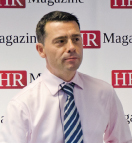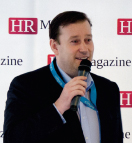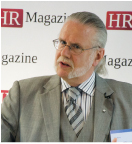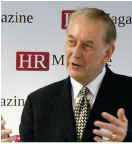
HR Magazine’s Spring conference shed insight on staff learning and development strategies. Our eight international speakers shared their experience and advice on best practices to help businesses attract, train and retain talent in the face of competition and better-paid positions elsewhere.
The conference looked beyond what courses should be offered to employees and took a step back to examine L&D as a holistic process. Speakers shared ideas on how HR can recognise staff members as unique and how leveraging their past experiences can help shape the way they learn new concepts, work with other people and cultures, and help them better retain acquired skills.

Tony Dickel
Tony Dickel
Founder, Chairman, Transcend International Group
Topic: Lessons on leadership in China.
The business world is rapidly transforming thanks to China Inc., Dickel elaborated, “The influence of the emerging super-powered regional multinationals is bringing Chinese ways, traditions and values to international attention.” It is also placing additional pressure on the already stretched global talent pool, with Eastern and Western corporations vying for the same ever-diminishing pool of talented individuals.
As for the outcome Dickel said, “The situation can be compared to a drought in the Serengeti; do all the lions get slimmer? No. You will end up with a few well-fed lions and the others simply will not survive.” Some may argue that investment in your employees could prove futile; an effort that must be repeated ad infinitum. Some also believe that the benefits of training are fleeting. Dickel asserts, however, that these doubts should be disregarded; that training and coaching provide a platform for innovation and allow a company to maximise the resources at its disposal.
In order to implement changes that will stand the test of time actions must be traced back to three sources: an individual’s ‘ways of doing’—their manifest behaviour; their ‘ways of thinking’—their attitudes, perceptions and the assumptions they make based on experience; and their ‘ways of being’—the deep-set beliefs and values ingrained in an individual since childhood. A good coach can train employees to see why they come to certain conclusions and therefore help harmonise workplaces containing employees from a variety of backgrounds and orientations. Leaders must learn to override conditioned predispositions, observe, learn and become self-aware in order to relate to people in far more suitable ways. Those who can embrace these processes can achieve transformational success.

Hew Evans
Hew Evans
Sony, Director, Regional Human Resources
Topic: Innovation in leadership development at Sony.
A truly global business
Evans clarified that from its Japanese heritage, contemporary Sony is hungry to accelerate globalisation. He highlighted the systematic approach it had taken to identify the next generation of global leaders. It was agreed that those with the greatest talent would succeed, irrespective of their present location. In the first instance regional MDs and HR departments had been asked to identify the top 10% of performers. This cohort had undertaken a two-hour on-line assessment to produce talent profiles. From this information, together with performance ratings and 360º evaluations, the final contenders were selected, leading to conception of the term ‘Hybrid Leaders.’
Evans elucidated that senior management had agreed upon a competency framework to be shared across the organisation for business-critical positions. Gaps had been highlighted in the organisational capability and talent nominated accordingly. Those not classified as future leaders were nonetheless issued with a personal development plan, and were told that they would be on the talent radar for programmes in the following year.
Coaching culture
In terms of succession planning the Global HR Board meets with Senior Management every six months to discuss the future of key roles. Three levels of leaders have been identified for the talent pipeline. Those classified as senior level were encouraged to coach those in the middle, the middle level coached the juniors and the juniors were encouraged to coach university students.

Hew Evans, Director, Regional Human Resources, Sony (pictured right) gives an insight into the importance of developing staff.
Holistic learning
Although candidates were sent to a base in Singapore their true journey was a holistic one on the premise that unless an individual can manage him or herself they are not capable of managing others. Here they took part in yoga and meditative practise with any tendencies towards PowerPoint-type presentations forbidden. Indeed, the Senior Leadership Programme involved placing staff in a circle for five consecutive days, with candidates and trainers placed acutely in their discomfort zone, but facilitating the sort of innovation that modern-day Sony desires.

Andrew J. Warneck
Andrew Warneck
Managing Principal of Leadership and Talent Consulting at Korn/Ferry International (HK) Ltd.
Topic: Learning agility as a strategic capability—The X Factor in developing leaders.
Warneck urged employers to focus their recruitment searches on finding candidates with ‘The X Factor’; that ‘indefinable something that makes for star quality’, according to Simon Cowell. Warneck, however, argued that whilst we cannot define it we can go some way to mapping it. Korn/Ferry has named the quality ‘Learning Agility’—the X Factor that, for the lucky few, makes them naturally blessed with a capability and an eagerness to learn new skills and view situations from different angles. And those judged to possess this ability, about 15% of the population, are said to be more likely to get promoted as their capability to adapt and better themselves, coupled with marked growth from feedback and trials, makes them a great asset to a company.
All is not lost for those without this disposition, as there are ways for individuals to hone their own learning agility such as harnessing their ambitions and motivations, throwing themselves into new situations, and trying to learn as much as possible from each experience.
Learning agility
For employers, Warneck advised looking to employ people with ‘Learning Agility’ during the hiring process by identifying those with a greater self-awareness, proven positive reaction and adaptability to change, with good communication skills and great insight. Warneck referred to the Paul Principle; an enhancement of the Peter Principle, “People don’t have to be promoted anymore to become incompetent”—with talent ever more scarce and job roles encompassing ever more tasks and skills, companies need employees that embrace and initiate change.

Ana Zysko
Ana Zysko
Manager, Operations Training, City of Dreams–Macau
Topic: Training is not an event—it’s a process.
Zysko opened with the captioned statement, aimed at management who overlook this fact, expecting training to ‘fix’ employees’ shortcomings, or provide them with a perfectly polished set of new skills. Her message was that training should be the on-going responsibility of all staff.
Ana admitted to being initially perplexed as to why the techniques she had so successfully deployed in the US were having such little impact here in Asia. When she took up post in Hotel Operations—Food and Beverages, at Macau’s City of Dreams she eventually uncovered the reasons. Firstly, tips did not act as incentive, and secondly the Western manner of service was not suitable in a predominantly Asian environment.
She asked delegates to consider whether their organisations had a process to tap into the incredible capacity of local employees for self-reflection.
Effective training strategies:
1. Needs analysis
- Document desired outcomes and management expectations.
- Issue anonymous questionnaires and surveys and host group discussions.
- From the gaps identify who needs training, the logistical implications and the best medium of instruction.
2. Development phase
- Allocate trainers and develop exercises.
- Run a prototype for managers so that they can understand the training, suggest any improvements and provide on-going support.
- Agree with management on how to introduce and sell the training.
3. Implementation Phase
- Set the expectation that skills should be incorporated into the workplace and clarify the consequences if they are not.
- Implement training and ensure that engagement levels are communicated to management.
4. Evaluation phase
- Test the service.
- Assess the effectiveness and ROI of the programme.
Zysko ended with a cartoon anecdote, starring fictitious waiter: Johnny B Good. The story went that having desired to develop his skills he was duly sent for training, returning to work as a fulfilled and productive worker. Yet the strip’s comical ending featured Johnny waking from his night-time slumber to discover that this had all been a dream. Given the success of the organisation’s 20 restaurants in applying the training model—it seems far from a dream. Zysko quipped, “From the City of Dreams, where dreams do come true.”

Matthew Longmore
Matthew Longmore
General Manager, Cliftons
HR Newsflash: Maximising attendance for L&D events—location preferences.
Cliftons’ survey results highlighted where T&D departments preferred to hold training in the city. Not surprisingly, the Central Business District (CBD) is the preferred location—chosen by 75% of those surveyed Both Admiralty and Wanchai were not nearly as popular. Longmore explained, “A reason for this may be that there is no good building stock around Wanchai MTR station.” Nearly 90% of respondents gave convenience of location a ‘very’ or ‘extremely important’ ranking. 73% said trainees spent 45 minutes or less to get to their training location—public transport being the preferred mode of transit.
The CBDs of Singapore, Sydney and Melbourne all earned top spots scoring 82%, 85% and 69%, respectively in terms of favoured location for T&D. Just over 50% of courses held in the city were only half-day or one-day in duration. “This shows how people are designing courses,” explained Longmore.
Organisations are designing shorter courses than ever for their staff and, to maximise attendance—hold it in a CBD location.

Clare Allum
Clare Allum
Asia-Pacific Learning and Development Leader
Emily Tang
Senior Manager—Learning & Development
Michele Lam
Director—Learning & Development
Ernst & Young
Topic: Building cultural integration through learning.
Clare Allum, Asia-Pacific Learning and Development Leader spoke on learning and cultural integration. She stressed the importance of aligning L&D processes and strategy with the organisation’s overall strategy. She added that when establishing policies HR should ensure they are also consistent with the organisational strategy—such as the number of CPD training hours professionals need to engage in.
Ernst & Young are moving certain work tasks to a shared service centre in Dalian. Allum highlighted that, during such moves, building consistent processes and policies was essential to ensure the organisation could best leverage its local presence and global scope. This also helps build local teams who report on best practices at a local-level. At the same time they are able to gain input from global teams—facilitating culturally integrated learning. Allum explained, “You get the benefits of consistency plus local knowledge and relationships.”
Emily Tang, Senior Manager—Learning & Development spoke on their talent management programme, Global NextGen (GNO), and its role in developing leaders from the next generation. She expressed, “We want our future leaders to have the ability to work across cultures.” When training talent, Tang considers that it might be their first time working in a diverse team; hence they have created smaller ‘geographic’ groups so that the trainees experience smaller geographic differences but different work cultures.
Michele Lam, Director—Learning & Development then spoke about their transition programmes, preparing someone with the knowledge and content—already in the company—to move onto the next level. Lam, like Allum, stressed the importance of consistency, “We share our knowledge from a global perspective.” She explained that organising training events isn’t easy because generally Western staff like to start early but Chinese staff people prefer to start later—coming up with a compromise is recognised as crucial to an event’s success.

Eric Bohm
Eric Bohm
CEO, WWF-Hong Kong
Topic: Learning and development insights from NGO perspectives.
Bohm repeated a question that he has heard many times throughout his career: why does a charity need an HR department? Communities, he lamented, expect that all charity organisations should be able to carry out great acts and achieve great outcomes with all donated funds going directly to the cause. Charities are often berated for having HR, IT, administrative and fund-raising departments, when without these the work would be impossible. When people look at the organisation and see 50% of its expenditure going on salaries and related costs they think that their donations are not going to their desired outcomes.
Bohm stressed, “The only way to deliver these outcomes is with people—and that’s what we invest in.” Donors want to decide where their money goes, be it to conservation or education, and for a fabled ‘someone else’ to pay for the ‘non essentials’. Bohm stressed that to continue doing their work these ‘non essentials’ need to be covered.
For NGOs the challenge is to get the support of talented people, who possess the skills and experience they need, whilst being unable to compete with the private sector on salaries. As a result, the WWF has to rely on brand passion to keep its employees enthusiastic since they are paid well below the market rate for their expertise. They also rely on time donated by people dedicated to the cause. Sustaining the motivation can be troublesome when projects have traditionally been completed in five to seven year cycles. To counter this, the HK Chapter introduced short-term goals so that staff can see the difference they are helping to make in society.

Nigel Banister
Nigel Banister
CEO, Manchester Business School Worldwide
Topic: Transforming talent—building leadership and management excellence—creating original thinkers.
Banister explained a key difference between leaders and managers was the ability to innovate. He cited a recent PwC survey that showed a third of c-suite executives believed ‘lack of awareness and experience in innovation and creativity’ was slowing down growth in their companies.
Banister also highlighted the importance of HR looking at the ROI in staff training programmes. He commented, “Training may change the behaviour of a person in a positive way, which will then lead to beneficial changes in terms of performance in the workplace.” Banister gave an overview of the highly acclaimed ‘Manchester Method’ in which courses are taught in a blended format incorporating an innovative approach to L&D based on the concept of learning by doing.
The Method is adopted on MBA and Executive Education programmes and taught globally through MBS’ executive centres in Hong Kong, Shanghai, Singapore, Dubai, Manchester, Miami and Brazil. The MBS Method puts students into project groups and aims to develop reflective practitioners—those who can take their learning forward. The way that the faculty engages with the students develops throughout the MBA course. Banister explained, “To start with, our faculty is very hands-on in terms of ensuring they learn everything about working in teams, moving through to the end where really they’re just acting like a mentor.”
Key benefits of managers studying an MBA:
- Immediate and direct application of new skills, ideas and strategies that can enhance business performance.
- Global perspective and an international network of contacts.
- Greater retention through enhanced motivation and commitment of your future leaders.
- Development of the skills, experience, tools and confidence required to drive your organisation forward.
- Complementary, high quality consultancy for your business via the project stage of the MBA.
- The flexibility of the blended learning format allows employees to continue working throughout their studies.






